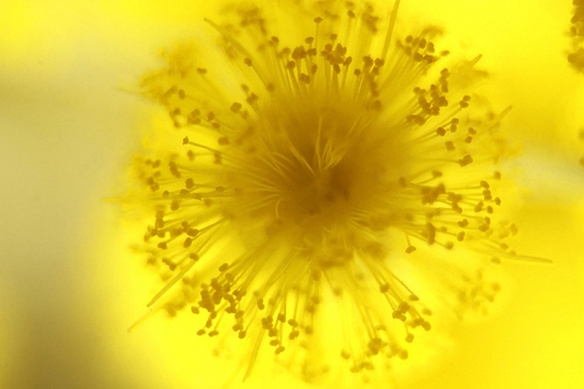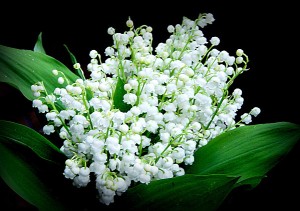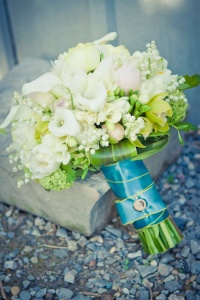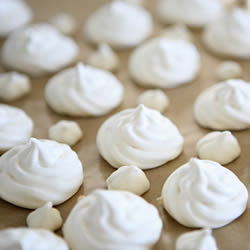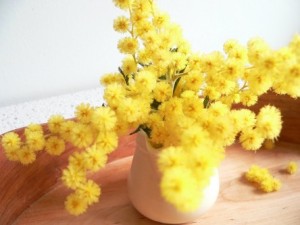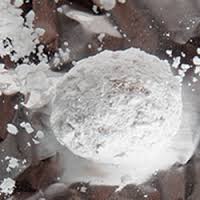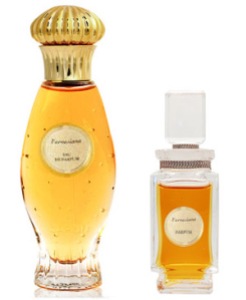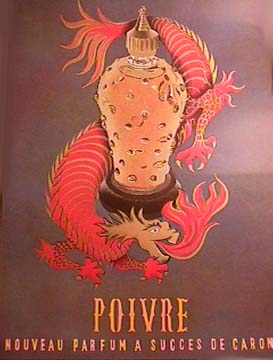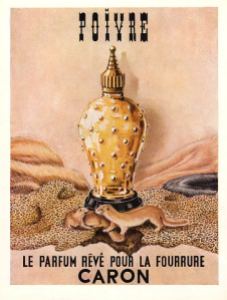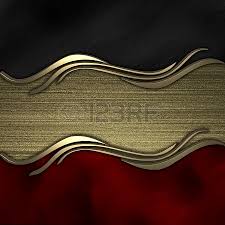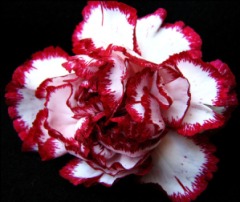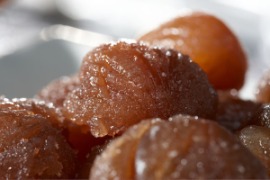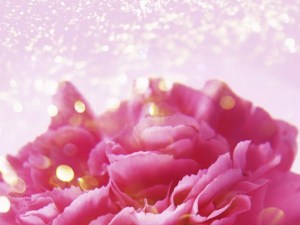Pastel floral ballerinas pirouette onto the stage in Nature’s version of Igor Stravinsky’s The Rite of Spring. Yellow acacia mimosa, pink heliotrope, purple violets, lilac hyacinths, and white lilies of the valley twirl daintily in the air, before being caught in the muscular arms of a creamy almond dancer. Sweet meringue powder rains down on them, while sandalwood peaks from the wings, waiting to slink onto the stage during the third act. It’s a dainty ballet, nothing like the raucous stridency of Stravinsky’s original, and it evokes the pleasures of a warm Spring day in a green field dominated by flowers and powdered pastries. It’s the ballet of Caron‘s Farnesiana.
Farnesiana was released in 1947, and was created by Michel Morsetti. It is one of Caron’s Haute Parfumerie “Urn Scents” which originated as extracts or pure parfums. I tested the parfum extrait concentration, but not the famous vintage version. I would have liked to, but, as with all of Caron’s most important fragrances, the vintage is not what most people have access to or can easily find, even on eBay. So, modern Farnesiana parfum is the focus of this review.
Farnesiana is a mimosa scent which Caron describes as follows:
Born in 1947, Farnesiana remains one interpretation of mimosa without many parallels on the market.
In order to capture its duvet-like appeal, Caron turned to the extraordinarily modern essence: sweet acacia, a lesser known variety of mimosa. Cleverly combined with latter, it lends the fragrance an almost mouth-watering sweetness.
The sweet acacia (Latin “Acacioso Farnesiana”) also provides the inspiration for its name, evocative of Rome’s Farnese Palace and the way of life redolent of sweet Mediterranean refinement and aromas.
Accords: Mimosa, sandalwood, hay…
Those three notes are the only things I am certain of when it comes to Farnesiana. Trying to figure out else what is in this perfume is an utter nightmare, with every site contradicting itself. Fragrantica says:
Overwhelming shades of sweet mimosa, floral and fruity blackcurrant.
In sharp contrast to that are the notes provided by The Perfumed Court, a decanting service rather well-known for its stock of vintage fragrances. For the modern Farnesiana parfum, they say the notes are:
bitter almond, mimosa, iris and lavender.
I don’t believe it that is the full extent of things, though I do agree that the perfume contains those notes. Caron’s most famous creations became legendary because of their complexity, which would thereby seem to involve more than a mere four elements.
In my opinion, Surrender to Chance‘s description and list seem the most complete and accurate to me, based upon what I personally detected. They write:
In 1947 Michel Morsetti created Caron Farnesiana based on Ernest Daltroff’s notes on the perfume before his death in 1941. Acacia, also known as cassie or mimosa, is the center of this creation, and it was one of the first fragrances to build around this note. It smells distinctly of almonds with that rich Caron Mousse de Saxe base, dark around the edges with a gourmand quality to it, though it veers away from being sweet and dries down to a great hay note. This is what a gourmand perfume could be.
[Notes:] Cassie (acacia or mimosa), bergamot, lily of the valley, violet, lilac, opoponax [sweet myrrh], vanilla, sandalwood, musk, heliotrope, mimosa, jasmine, hay.
Bois de Jasmin quotes something similar, though not as detailed, so I think Surrender to Chance may have the truest assessment of Farnesiana’s elements. That said, I think The Perfumed Court is correct in noting lavender is a potential suspect as well.
Before I start, I need to confess a weird bias I have when it comes to mimosa. It is a flower which holds great personal symbolism and meaning for me, so I have especially high standards when it comes to fragrances featuring it. As a child, one of the places I lived had numerous acacia or mimosa trees. The mere sight of their graceful, fluffy, yellow beauty against the turquoise skies always gave me great comfort, especially during a very difficult period when I was quite ill. For me, mimosas are something bound up with joy, nostalgia, longing, and bitter-sweet memories of my childhood. And their scent is firmly imprinted on my nostrils.
As a result, it was initially somewhat difficult to review Farnesiana in its current form. I never tried the vintage version, so I have no personal experience with its smell, but I do know that Farnesiana is explicitly intended to be an acacia mimosa soliflore that pays homage to the note. On my skin, the current version is very far from that — so much so that it was a problem at first. After a while, however, I simply told myself to mentally approach Farnesiana in a vacuum, and to merely consider it as a general floral scent, not a mimosa one. I suggest you read this review in that same light, and consider Farnesiana as a fragrance unmoored from its past or from what you may have heard about its former self.
Modern Farnesiana parfum opens on my skin with a mimosa note that is very wan, very pale, and powdered. It is sweet, bordering on the syrupy, but it doesn’t feel like a rich, deep, concentrated mimosa, and it certainly isn’t the mimosa of my childhood. Within seconds, it is followed by dewy violets, honeyed sweetness, and lily of the valley, or “muguet” as I’m used to calling it. There is also the tiniest whisper of both iris and jasmine. On their trail is a muscular, strong, bitter almond smell that pushes its way onto center stage to flood over all the flowers.
The mimosa is disappointingly weak for a concentrated extrait parfum meant to highlight the note. Yes, there is a clear and distinct aroma that is sweet, but it also feels like a translucent shadow of itself. Part of the problem is the very watery undertone to Farnesiana’s opening, thanks to the effects of the dewy, green muguet. To my disbelief, the blend of lily of the valley, violets, and an almond-infused iris sometimes seems stronger than the mimosa on my skin. All the flowers are infused with honey to create a floral bouquet that is, admittedly, very yellow in its visuals, but also green. The overall effect is quite strangely watery, and the best way to describe it is to compare it to a nectar. An agave nectar, in fact, which is a thin, pale, honeyed liquid.
I don’t understand what Caron has done, particularly as this is the same perfume house which puts out Montaigne, an affordable eau de parfum (not an extrait) that is filled with copious amounts of deep, yellow mimosa. I know because I own Montaigne, though I constantly struggle with its suffocating, somewhat oppressive heaviness. But at least Montaigne seems like a solid blast of hardcore mimosa (with jasmine and daffodils), whereas Farnesiana seems like a general floral scent which merely happens to have some pale mimosa as well. It is almost bewildering how the muguet feels like one of the main players in the opening minutes, along with the increasingly powerful, dominant almond note that starts to take over at the end of 10 minutes.
It is at this point that I told myself to put aside all expectations of a mimosa scent, and to consider Farnesiana as a floral-almond fragrance with dewy nectar and light honey. By that light, then Farnesiana is pretty indeed. It’s a lovely blend of very spring-like, dewy, almost syrupy flowers in a spectrum of green, white, and yellow. There is the lightest suggestion of powderiness, at least initially, and it feels as though sweet pollen were sprinkled over the bouquet in a pretty counterbalance to the agave nectar.
A newcomer slowly creeps onto the scene to join the blend of watery muguet, bitter almonds, dewy violets, yellow acacia mimosa and honey. It’s hay, and it smells dry, sweet, fresh, and, oddly enough, rather wet, all at the same time. Perhaps it’s the overlapping trace of the muguet that creates that water-logged impression, but I can’t help imagining drops of rain hanging off bales of sweetened hay in a field of yellow and green. In addition, there is now a definite grassiness to Farnesiana’s undertones as a whole, a grassiness that extends far beyond the sweet hay. It feels like the scent of bright, sweet, summer’s grass, as you lie on your back in the warm soil in a field of flowers, as the warm sun shines down on you, amplifying the smells of nature.
20 minutes in, new notes arrive, and Farnesiana realigns itself. The focus of the scent shifts away from the lily of the valley, violets, and that hint of iris to something completely different. For whatever reason, I smell narcissus or daffodils as much as I do the violets. There is absolutely no doubt in my mind that there is a daffodil note wafting from my skin, and it leads me to wonder if Caron’s more recent Montaigne was created as a more heavy, opulently floral, non-gourmand riff on the original Farnesiana. One fragrance very much feels like the mental inspiration for the other, even if there are substantial differences between the two scents. But, as in Montaigne, Farnesiana is manifesting daffodil in both its sweet floral facets and it’s almost hay-like drier ones.
My impression of daffodils is short-lived, however, because it is soon replaced by a stunning note of hyacinth. At first, it is a muted, muffled element that hides behind the almond note that has increasingly become Farnesiana’s most dominant characteristic on my skin. I absolutely love hyacinths, especially the purple kind that you buy in pots in Spring. It is one of my all-time favorite floral notes, but I’ve never found a perfume that has managed to bottle its unique aroma.
For me, hyacinths smell like a mix of greenness, dewy syrupiness, wet soil, woodiness, and an ethereal liquidity. There is a crystal-like clarity to the floral sweetness; it’s like an Alpine stream that takes in all the blackness of sweet soil, the wateriness of the flower, the greenness of its leaves, and, yet, somehow, still manages to feel as clear as a bell. It’s a hard smell to describe, but it’s absolutely there in Farnesiana. I’m over the moon, while simultaneously feeling somewhat crushed that the hyacinth is so muffled and so thoroughly infused with the bitter almonds.
It’s at this point, about 20 minutes in, that I suddenly realised just how much Farnesiana is like a floral march through Spring. It’s reminds me of that old childhood song about “the animals go marching in,” two by two. Here, it may be more three by three, with that wan mimosa note and the muscular, bitter almond being the first two, and the third place being taken by a steady succession of different flowers. First, it was the lily of the valley, while the violets (and, to a much lesser extent, the iris) looked on from the sidelines. Then, the muguet retreated to make way for the daffodils for a brief moment, before they passed the baton to hyacinth. In all cases, the flowers trail behind the almond and that thin mimosa note, infused with acacia honey and a touch of powder. It’s also like a more harmonious, melodic, floral version of Stravinsky’s Rite of Spring, where several members of the Corps de Ballet take turns in pirouetting in the limelight, while others (like the hay and grass) gracefully lie curled over in the far corners.
Farnesiana feels deep and rich, in the softest way imaginable. Its notes develop like smooth satin on the skin, except they feel weightless and airy at the same time. The perfume’s hues may translate to a soft buttercup yellow and white, but the delicate scent is wonderfully rich. It seeps over the skin like liquid nectar, with decent projection at first. Three small smears of parfum produced a soft cloud that initially hovers 2 inches above the skin.
From afar, the almond note isn’t so dominant, and Farnesiana appears as a sweet, light, honeyed, somewhat dewy nectar of floral mimosa, almonds, and hyacinth. I can’t get over how lovely the hyacinth is, though it teases me by slipping to hide behind the almond. The other flowers have folded into the mix at the 40 minute mark, and aren’t so easy to pull out in any individual way. The wet, earthy soil tonality from the hyacinth remains, along with its greenness, and the sense of floral liquidity, but the hay, violet, and muguet have largely faded from my skin.
Then, at the end of the first hour, things suddenly change again. The heliotrope slinks in, all pink and white, smelling of powdered vanilla meringues with a touch of marzipan. It takes some of the bitter edge off the almonds, softening them, and slowly bringing in a new form of sweetness. Instead of honey nectar and the hyacinth’s liquid, green syrup, the focus very gradually shifts to vanillic powder and almond-dusted treats.
The heliotrope grows stronger with every passing quarter-hour, turning Farnesiana into a scent that is predominantly French vanilla meringues and bitter almonds, lightly flecked by a nebulous sense of wan, quasi-mimosa powder puffs, and honeyed nectar. 90 minutes in, the hyacinth moves back to join all the other flowers on the discarded heap. Farnesiana’s sillage softens even further, hovering less than an inch above the skin, though the scent itself remains heady, deep, and very rich in feel.
Unfortunately for me, Farnesiana turns into a skin scent after 3 hours with 3 big smears of scent, and in even less time with a smaller quantity. Extraits are said by some to be much softer in sillage than eau de parfums (because of some technical issue involving the burning off of the alcohol base in the latter, I think), but Farnesiana’s projection is substantially weaker than most Extraits that I have tried. It’s disappointing, I have to admit.
Farnesiana remains a heliotrope-centered fragrance with powder-puff floral sweetness until the start of the 4th hour when the sandalwood rises up from the base. It’s a problematic note for me, especially in the beginning. The wood is vaguely creamy, slightly sour, fully bland, and definitely not Mysore. It has touches of cinnamon and a subtle smokiness that are nice, but also flickers of ashiness that are not. On occasion, there is even an undertone that even translates as stale and dusty, almost as if this were Guaiac wood more than “sandalwood.” When all these more negative facets appear, even in a mild form, Farnesiana’s drydown is less enjoyable and the perfume feels like a sudden shift into dryness. For a brief 20 minutes, the perfume smells like a stale, dusty, dry, Australian sandalwood infused with almonds, heliotrope meringue powder, a suggestion of smoke, and a dash of cinnamon.
Then, Farnesiana shifts again. Suddenly, the strange undertones to the sandalwood disappear, the wood turns creamier, and lavender appears on the scene. I had thought The Perfumed Court must be mistaken in including lavender in their brief list of notes, and I certainly haven’t seen any other bloggers mention smelling the flower, but it was definitely there on my skin during one of my tests. Interestingly, when I applied less of the fragrance, the lavender didn’t show up, but I attribute that to how sheer Farnesiana is as a whole when you use a low dosage.

Source: A Spicy Perspective. (For recipe for lavender chocolate ice cream, click on photo. Website link embedded within.)
At the end of the 5th hour, the perfume has suddenly transformed into a sweetened, creamy, lavender and heliotrope scent that reminds me of a lavender ice-cream dusted with meringue powder. The now creamy sandalwood lingers at the edges, alongside the tiniest hint of something smoky, though both elements are muted and muffled. The whole thing feels like a gauzy wisp on my skin, and the specific nuances are sometimes hard to detect. Farnesiana is not a powerhouse by any means!
The perfume quickly softens even further. Soon, it’s just a blur of powdered sweetness with the tiniest touch of an abstract dryness. Farnesiana remains that way until its very end. All in all, the fragrance lasted just under 8 hours on my skin with 3 good smears, amounting to about one very big spray of parfum extrait. With a smaller quantity, Farnesiana lasted between 6.5 to 7 hours.
As a whole, bloggers seem to give good reviews to Farnesiana parfum, even in its current form. Everyone agrees that the vintage version was amazing, but they generally seem to like the modern version too. (At least, whatever modern version they tried in 2011 and, in one case, 2012. Who knows what further reformulation may have taken place since then.) I’ll start with the review at Now Smell This where Jessica also includes a useful, quick survey of other people’s impressions of the scent:
I’ve always considered Farnesiana a sophisticated comfort scent, an unusual floral-gourmand (or “fleurmand,” as I like to call this perfume sub-genre). To my nose, Farnesiana begins with a powdery, pollen-like mimosa note and with accords of sun-warmed hay and grass. Oddly enough, this green-tinged phase reminds me of certain fragrances from Santa Maria Novella, like Ginestra (Broom) or Fieno (Hay), that evoke meadow-like landscapes. Farnesiana’s heart opens up to reveal the sweetly resinous opoponax — one of those notes that I might or might not love, depending on the context, but I do like it in Farnesiana. Then there’s also a considerable amount of dusty almond with just a hint of fruitiness (the black currant) and a drop of vanilla. I also detect a cool lilac note, although some of the other listed florals are not as apparent to me. The base of the composition includes just enough soft musk to make Farnesiana’s far dry-down a refined skin scent for me.
Of course, the issue that I’ve been skirting up to this point is the question of possible reformulation: has Farnesiana been altered over the years, and if so, for better or for worse? The sample I’m using right now was acquired directly from the Caron boutique in New York City just a few weeks ago, so I’m assuming it’s the most recent version. I’ve only been familiar with Farnesiana for about six years; in my memory, it was a little plusher and more golden when I first sampled it, but the current Parfum still “feels” like Farnesiana to me. However, I haven’t sampled any truly “vintage” Farnesiana. Erin, who has gone further back, regretfully calls today’s Farnesiana “a pale non-entity”; in Perfumes: The Guide, Tania Sanchez finds little to love in the current fragrance after sampling a 1950s original.
On the other hand, Victoria of Bois de Jasmin thinks Farnesiana’s current formulation is very well done, and I tend to side with her on this one. For me, Farnesiana is still an intriguing fragrance, something hard to define, somehow gentle yet moody and changeable. I’d recommend trying it if you usually enjoy soft almondy scents or meadowy-grassy florals, since it combines these two ideas. Of course, if you’re already deeply in love with a much earlier bottle of Farnesiana, the current offering might disappoint you[.] [Emphasis to names added by me.]
Speaking of Bois de Jasmin, her review is useful because it compares the smell of Farnesiana from a super old bottle from the 1950s, to one from the 1990s, and to the version closest to her time in 2011. She gives Farnesiana an overall Four Star rating, and her review reads, in part, as follows:
Caron Farnesiana defies conventions with its interpretation of violet and almond tinged mimosa notes. The classical softness of mimosa is rendered as suave and tender, yet the effect is more like delicate swirls of incense smoke rather than the swan dawn lightness of spring flowers. Farnesiana has an elegant, mellifluous character, yet at times it speaks in sultry whispers, with the overall impression of the fragrance being surprising, dramatic and at times unpredictable. […][¶]
The warm and powdery fragrance of cassie flowers has an interesting undertone of balsamic spiciness, which is fully explored in Farnesiana. The composition hits the sonorous, dark notes immediately, giving a glimpse of its incense and sandalwood inlaid base. The honeyed sweetness of mimosa is rendered as the luscious richness of almond nougat, which when paired with the dark woody and ambery notes makes for an exciting counterpoint to the plush floral notes. Initially Farnesiana has a luminous quality, augmented by orange blossom and jasmine; as it dries down, the incense and musk give it a more somber and seductive hue. […][¶]
The most recent version of Farnesiana I have smelled struck me as very good. The main difference is the stronger vanilla note and the clearer, brighter floral accent which serve to give Farnesiana a more baroque aura. [snip.]
My experience is obviously nothing alike to what she is describing or to what Farnesiana apparently used to be. On my skin, there is absolutely no strong incense accord, no dark notes, no orange blossom, and, in fact, totally different florals.
What I encountered closer to what The Non-Blonde experienced in late 2012. Her review from the time brings up Guerlain‘s L’Heure Bleue, and talks about it in a way which leads to me to believe that, once upon a time, perhaps the two fragrances shared some similarities. Well, not now. Not on her skin, and most definitely not on mine! Her review reads, in part:
There’s a moment during the development of Caron’s 1947 classic Farnesiana that I suddenly get it. The mimosa note, sunny and golden, comes out and it’s beautiful. What happens next depends on what version and vintage of Farnesiana you have on your hands. I remember an older sample I had that was dark and held a certain mystery. My current decant of extrait de parfum is new and I’m not too crazy about it[….]
The version of Farnesiana in front of me is very powdery, almondy with a touch of anise. The mimosa note is there briefly, but it’s somehow frothy and airy and not as complex and rich as I remember. Then there’s the heliotrope-almond-anise which should be bleue and melancholy, but somehow it’s not. Instead, I get all powder all the time and not nearly as romantic as it needs to be. Farnesiana goes up in a fluffy and soft musk that’s pleasant enough but isn’t too interesting. […][¶]
[This] version of Caron’s Farnesiana […] is scrubbed clean and then powdered within an inch of its life. […] Now, don’t get me wrong: Farnesiana is perfectly nice even in this version, and lovers of powdered almond pastry could do far worse. It just doesn’t ring my bell quite as intensely as I hoped.
On Fragrantica, the majority of people seem to adore modern Farnesiana. A good portion of them succumb to the gourmand elements and to the powdery note (even though no-one seems to recognize it as heliotrope). Several people like the almond aspect as well. Generally, Farnesiana is described as a sweet, powdery, floral scent with mimosa that turns either vanillic or woody-vanillic in its drydown, depending on perspective. However, there are a rare few who struggle with the hay note, and find it unpleasant. For the most part, though, the overall consensus is of a very enjoyable floral scent with gourmand facets.
As an Extrait, Farnesiana is expensive for the tiny size of the bottle. 7.5 ml will cost you about $100, which is one reason why I tried to use an amount similar to what the average person might apply from such a bottle. In contrast, you can buy 50 ml of the Eau de Parfum for only $30 more at $130. Extraits and eau de parfums differ beyond just the question of concentration or richness. Often, a variation in formula is used, resulting in different notes being highlighted or sharpened.
I haven’t tried Farnesiana’s eau de parfum, so you might be interested in the a review of it from “Doc Elly,” otherwise known as Dr. Ellen Covey of the Olympic Orchards indie niche perfume house. (The Fragrantica page for Farnesiana is the same one for both Parfum and EDP versions, so always check to see which concentration someone is talking about.) Her Fragrantica review is for the 2012 (or earlier) version of the Eau de Parfum, and states:
Mimosa and leathery violet, powder and almondy heliotrope dominate in the beginning, but this EdP quickly dries down into a realistic, non-sweet rendition of yellow mimosa. It’s a beautiful scent that reminds me of springtime in the south of France, when the mimosas bloom. After an hour or two the base of vanilla and white musk becomes prominent. Toward the very end, a little sandalwood appears.
Sillage is moderate. I love the mimosa opening, and the drydown is pleasant to have lingering during the rest of the day. On skin, it lasts at least 6-8 hours. Farnesiana begins as a lovely, cheerful spring-like powdery floral scent that gradually becomes a warm gourmand-ish musky one. I like it very much, and would enjoy having a decant and wearing it on occasion..
Her experience largely mirrored mine with the Extrait Parfum, right down to the longevity, so the EDP might be a better deal as a whole.
I think Farnesiana is a very pleasant fragrance if you free yourself from expectations or memories of its prior self. It left me a wee bit underwhelmed with its overall simplicity, and I wasn’t enthused by the sillage, but I found some parts of it to be really pretty indeed. The hyacinth part is truly lovely, as is the march of the floral brigade in the first two hours. If a bottle of Farnesiana ever landed in my lap, I would definitely wear it on occasion. So, if you’re looking for a soft, feminine, powdery floral with gourmand undertones and the sense of Spring, you may enjoy Farnesiana quite a bit. Those who love heliotrope’s vanilla meringue character, as well as almonds in particular, should definitely consider giving it a sniff.
In short, Farnesiana might be a lovely way to usher in Spring.



